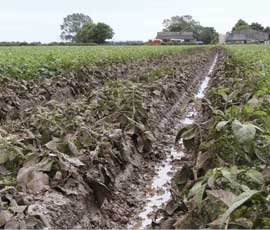Blight update shows positive signs

Extreme blight pressure and the concern about a new blight strain this season has caused anxiety in the potato industry, but at a mid-season update at the Potatoes in Practice event, near Dundee, it’s not all doom and gloom
Potato blight has been widespread this year, but where growers have been able to maintain a tight spray programme, good control has been achieved.
“There is a very mixed picture around the country and where programmes have been disrupted, infection has been seen, which isn’t surprising given the conditions,” said Mike Storey, head of research and development at the Potato Council.
“It’s been damp, humid and there is standing water in rows, which has provided the ideal atmosphere for the spread of blight. Where people have been able to get on, though, the programmes are holding up,” added Dr Storey.
Dry conditions at the early stages of planting would usually be a positive sign, resulting in fewer oospores and reducing the chances of tuber blight developing. But then the rain arrived.
“This resulted in blight appearing very early, with outbreaks occurring in early May,” said David Cooke of the James Hutton Institute.
“On 11 July we had counted 5,587 Smith periods nationally, compared with 1,034 at the same time in 2011, which is more than five times higher.”
This year, samples from blight scouts have found 335 outbreaks, which is significantly higher than the 183 this time last year, reflecting the extreme disease pressure growers are facing, Dr Cooke pointed out.
Blight strains
With much attention paid to the discovery of the blight strain Green_33 in Norfolk last year, there was concern it could be more widespread this season.
“So far it has only been the usual 6_A1 and 13_A2 strains that have been found,” said Dr Cooke.
“Although we have only processed about 50 samples out of the 500-600 available, we have focused our attention in the areas that Green_33 is most likely to appear.
“It’s encouraging that it has not been present from a control point of view, with some Green_33 isolates being insensitive to fluazinam,” he explained.
Dr Cooke noted that Dutch research has found that although there is some insensitivity to the active ingredient, it is not as competitive as other blight strains.
“Therefore, the advice remains – make sure you are not using fluazinam in more than 50% of your blight fungicide programme to reduce the risk of selecting for insensitivity,” said Dr Cooke.
Tuber blight
There is a fear that tuber blight could be an issue this year, with wet and cool conditions ideal for the disease to move from the foliage on to the tubers.
“This may not be the case,” says Ruairidh Bain, potato consultant at the SAC. “In 2007 there was a perception that it was going to be a problem, then it dried up and we had higher temperatures.
“The key for growers is to concentrate on keeping infection out of the canopy, which will minimise the risk of inoculum reaching the tubers if conditions are conducive to tuber blight,” said Dr Bain.
Read more from the Potatoes in Practice event

